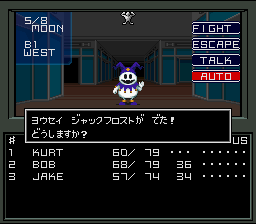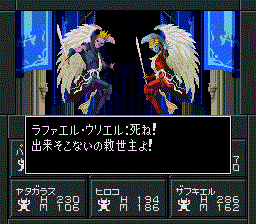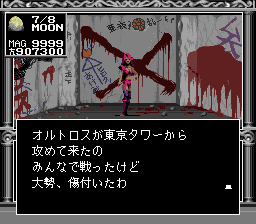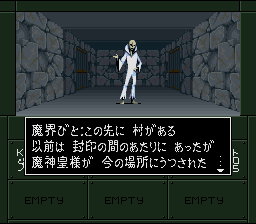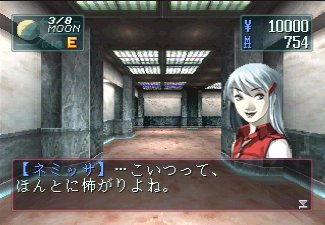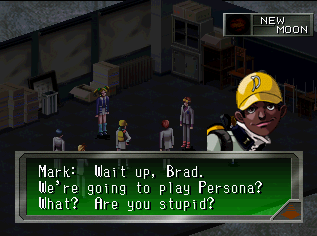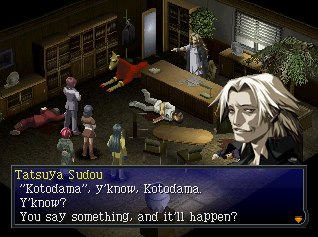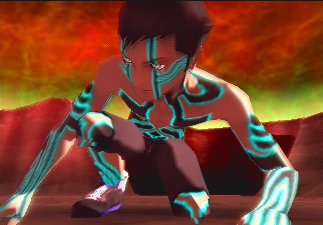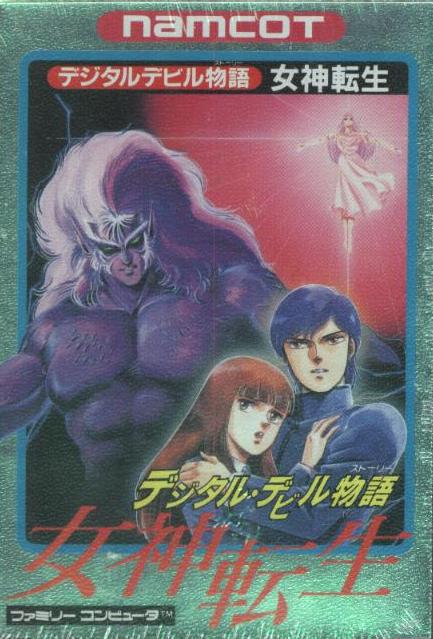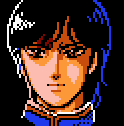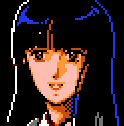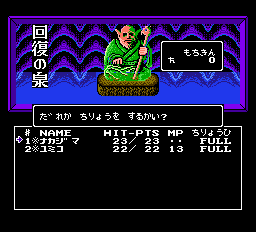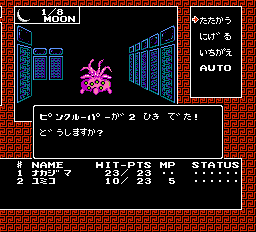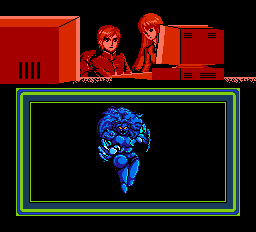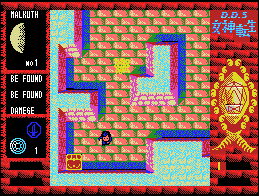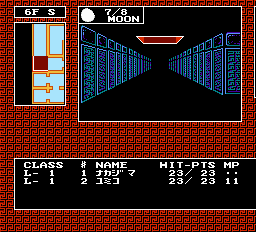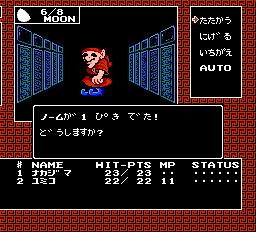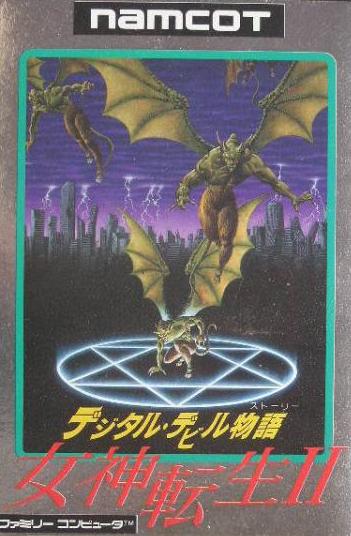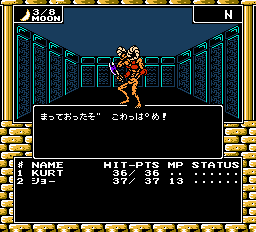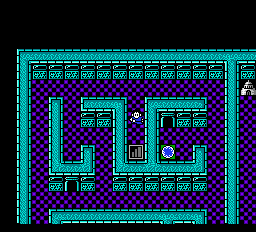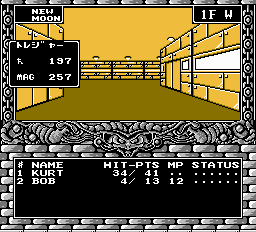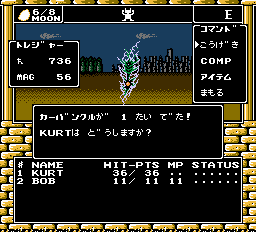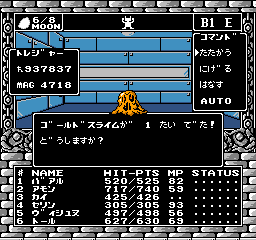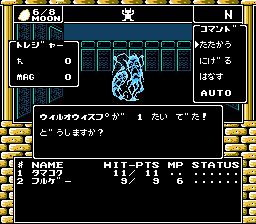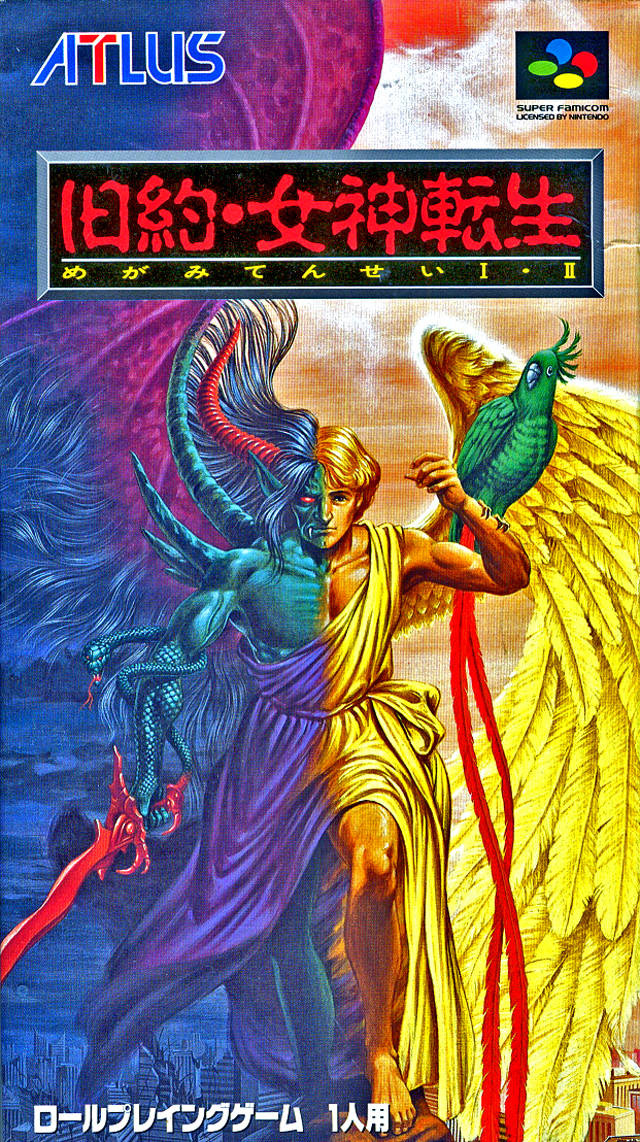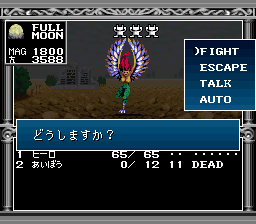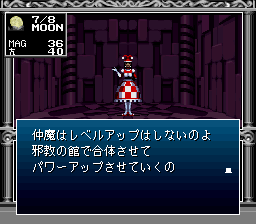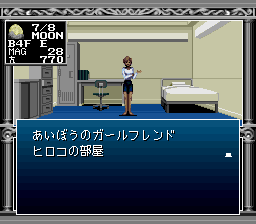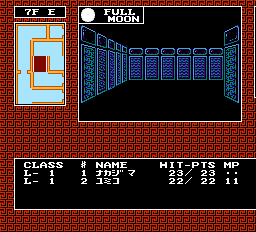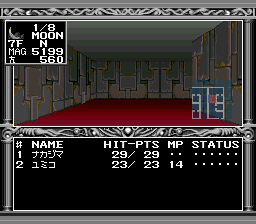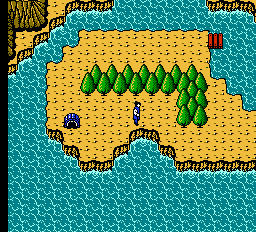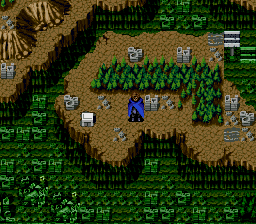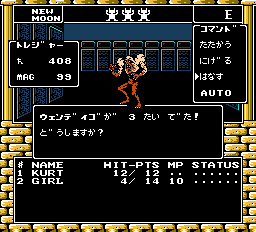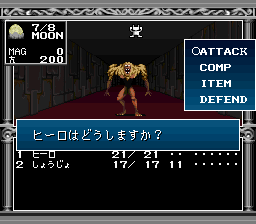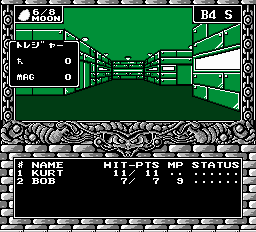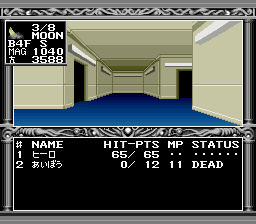
Megami Tensei
Megami Tensei / Shin Megami Tensei
|
<<< Prior Page |
|
Page 1: |
Page 2: |
Page 3: |
Page 4: |
|
As long as console RPGs have existed, Japan has been dominated by the likes of Dragon Quest and Final Fantasy. But somewhere, just outside of the mainstream, lies the Megami Tensei series. Filled with dark stories about the nature of reality, technology, religion and humanity, the Megami Tensei storylines have been a bit too obtuse, and the gameplay a little bit too hardcore, to really attract the typical RPG fan. But the series - mostly relegated to Japan until recently - has created a cult following known as Megatennists, who devote themselves to one of video gaming's most expansive series.
Megami Tensei began as a novel by Aya Nishitani, which you can find English translations of here. The story was about a young computer genius named Akemi Nakajima who had tapped into the world of demons through the use of computers - hence the subtitle "Digital Devil Story". Naturally, things go horribly wrong when he summons the evil fiend Loki into the real world, and it's up to Nakajima to right the wrongs he created. Namcot bought the video game rights and turned it into a role playing game for the Famicom. Its sequel, aptly named Megami Tensei II, created a completely original story but kept the same unique gameplay systems. Once Shin Megami Tensei came out for the Super Famicom (having switched publishers from Namcot to Atlus), the series exploded into an underground phenomenon.
Megami Tensei translates to "Reincarnation of the Goddess" - this is because the female protagonist in the original story was the reincarnation of the Japanese creation deity Izanami. The title is open to interpretation in all subsequent games, but almost all of them contain females in strong roles. When the series came in the 16-era, it was named Shin Megami Tensei, which has stuck ever since. Literally this means "Reincarnation of the True Goddess" - however, the Japanese often use "shin" (a symbol which means "true") to show an evolution of some kind. (Other examples of this includes "Shin Sangoku Musou", known as Dynasty Warriors 2; Shin Contra, known as Contra Shattered Soldier; and Shin Samurai Spirits, or Samurai Shodown II.) It's roughly equivalent to the English word "super", which was stuck in front of practically every Super Nintendo sequel back in the day.
Taking a departure from most Japanese console RPGs, which usually borrow the overhead perspective of Dragon Quest, Megami Tensei bases itself off of American computer RPGs like Dungeon Master, featuring a first person perspective as your character moves through huge, maze-like dungeons. While this aspect may be off-putting to many people (and more recent games have adopted the traditional third-person viewpoint), the series shouldn't be dismissed outright for being a bit different. Besides, all of the games feature automapping functions, so you don't feel too helplessly lost. In between the first person stages (usually known as "3D dungeons") are overhead maps where you move to different areas (dubbed the "2D field".)
Despite the advancements of the series over the years, the core gameplay has remained consistent. Megami Tensei is particularly unique in the way you assemble your party. Your main character is usually a human and unable to use magic. While your secondary human compatriots often have the use of spells, the only way to find new allies is to recruit your enemies. Building a huge demon army is an absolute necessity to get anywhere, as Megami Tensei places extraordinary importance in utilizing elemental strengths and weaknesses, much more so than the typical RPGs. Nearly every opponent in the game can be engaged in conversation, and if you manage to convince them of your sincerity, they'll join your party. This is quite bizarre, in both concept and execution - finding the right responses to appease various demons is often a result in trial and error - but it's an interesting deviation from the norm. Often times conversation is an also important strategy for staying alive - sometimes your opponents will leave you alone, or give you items if you have the right team members. All monsters are powered by a force called "Magnetite", which is earned after battles. Summoning too many monsters into battle will drain this quickly, so finding a balance is an absolute necessity.
While human characters gain experience and levels like most RPGs, your demons are a bit different - the only way to make them stronger is to combine them with other demons. By entering a specific building dubbed a "Jakyou", you can take two (or three) of your pet demons and merge them to create a powerful monster. Intimate knowledge of practically every monster in the game is practically mandatory in Megami Tensei games, which is one of the main reasons why it can be intimidating to casual gamers One of the biggest elements introduced in Shin Megami Tensei was the freedom of choice between three completely different paths: Chaos is the idea of total anarchy and Darwinian "every man/demon for itself" philosophy, and is associated with Lucifer. Law is the complete opposite, offering a set of rules so that order that be maintained, associated with the likes of God. Neutral is somewhere in between, defying both sets of rules and stressing individuality. None of the paths are completely right or wrong: the Law alignment comes off as something of a dictatorship, and while Chaos represents freedom, it also allows for a hearty amount of pain and suffering. Finding where your allegiance lies - or casting off both and creating your own path - is a big part of the Megami Tensei philosophy, and these types of deep, personal choices are rarely seen in video games. The multiple paths also allow for plenty of replayability, as your choices alter the ending of the game.
Despite attracting a fanbase in its native land, the series only saw rare releases in English. These were mostly installments from offshoot series - Revelations: Demon Slayer for the Game Boy Color and Revelations: Persona were some of the first titles in the series to appear in English. It wasn't until Shin Megami Tensei Nocturne for the PlayStation 2 that Western gamers could experience a true Megami Tensei title. But why did it take so long?
The series first came into fruition in the 16-bit era, long before RPGs were popular in America. And even after that, the series could be too perceived as too difficult and foreign for an audience accustomed to Final Fantasy. But probably one of the biggest reasons that the Megami Tensei series remained stuck in Japan are the controversial storylines. Post-apocalyptic landscapes are a popular trends, featuring ruined worlds where the remnants of humanity must struggle to survive against the tenants of the demon world. Almost all of the monsters are based off creatures from mythologies from around the globe, ranging from Hindu deities like Kali and Vishnu to Norse gods like Thor and Loki. However, there's a lot of influence from Judeo-Christian lore, and a lot of it is bound to offend those in the Bible Belt. The Christian god Yahweh, who appears in Megami Tensei II and Shin Megami Tensei II, is portrayed as an overlord meant to fool human beings into faith, only to have them exploited for His own gain. There seems to be a recurring Japanese dislike of Christianity evidenced in many RPGs (especially during the 32-bit era, with games like Final Fantasy Tactics and Xenogears), but none of them have been so blatant as to name the actual God, one of which a sizeable portion of the globe believes in, and portrays Him to be mankind's great nemesis. While not all of the titles are steeped so deeply in religion, it's still one of the defining themes of the series.
Yahweh, according to Megami Tensei
In line with the original plotlines and themes are the unique aesthetics that Megami Tensei exudes. Since the days of the Super Famicom, most of the artwork has been has been done by Kazuma Kaneko. A far cry from the flamboyant designs of Final Fantasy or the light-hearted warriors of Dragon Quest, Kaneko portrays his characters with far more realism than one normally sees. His human characters often have pale skin, complete with brooding stares. Demons are characterized by elaborate, glowing tattoos. The monster designs show creative interpretations of other cultures B the "bondage angel" being one of the most infamous. There's no artist quite like Kaneko, and he's become synonymous with the series. His early works are quite different from his recent designs, which occasionally go overboard into goofy territory by arming his heroes with capes and gigantic keyboards strapped to their arms. But even then, they're completely different than pretty much anything else you=re likely to see anywhere. But he's more than just an artist - Kaneko, along with series producer Cozy Okada (head of the R&D 1 team responsible for most of the earlier Megaten games), have been considered the masterminds of the series.
The music is also squarely distinct from most any other games on the market. Since the Megami Tensei games take place in a more modern era, it makes sense that their soundtrack draw from more contemporary styles, ranging from heavy guitar rock to dance-techno. The army of composers have been wide throughout the run of the series, from early works by Tsukasa Masuko to more recent compositions from Kenichi Tsuchiya and Shojo Meguro. But they've almost always been excellent.
There are several offshoots of the Megami Tensei series, and while they share gameplay elements (primarily the monster recruiting and creation elements), they greater differ in tone and setting. The Devil Summoner games take place in a modern day Japan where demons roam free, and steers clear from all of the post-apocalyptic setting and religious overtones - the second game in the Devil Summoner series, Soul Hackers, has particularly strong cyberpunk overtones. In general, the Persona series are aimed as more casual RPG players, offering a heartier focus on characters and story telling. The third and fourth Persona games are drastically different from the first two, integrating elements from life/dating sims and featuring randomized dungeons. The Last Bible games began on portable platforms, take place in a traditional medieval setting, and play very similar to Dragon Quest. The Majin Tensei games are strategy RPGs using the Megami Tensei play mechanics, which eventually evolved into the DS game Devil Survivor. The Devil Children (AKA Demikids in America) series aims to attract kids with its bright anime graphics, undoubtedly to tap into the Pokémon phenomenon. The Digital Devil Saga / Avatar Tuner games take place in a dystopic world, and attempts to bring more gamers in the fold by simplifying the character building systems by getting rid of demon gathering altogether.
Despite the series being so widely spread, there are bits of commonalities shared between theme. Much like how "gil" is the currency in every Final Fantasy game, the monetary unit used in the Megami Tensei games are dubbed "makka", denoted with a symbol that looks something like a British pound sign. You'll find similar enemies in many of the games - much like how the grinning slime from Dragon Quest has become a mascot for Enix, the overly-happy Jack Frost has appeared in so many Megami Tensei games that he's become the mascot for Atlus, and even starred in his own Virtual Boy game. And while each of the subseries takes place in its own continuity, there are occasionally references and characters tying them together. This is especially true between Devil Summoner and Persona, since they both take place in modern day Japan.
Thanks goes to all the people at Megaten Haven board for their help, especially Brand and her excellent Jack Frost's Corner artwork site, where many of the character images were taken from. Additional thanks go to Remiel-san for his excellent FAQs, Ian Kelly and GideonZhi for the spectacular translations of the Super Famicom games, Simon Finger for letting me know about the If... movie, Jon Lung for grabbing me that copy of Innocent Sin while in Japan, Dais for the Majin Tensei II MP3s, ReyVGM for the PC Engine system card screen, and Brett Schwartz for lending me his copy of the PSOne Soul Hackers.
Links:
Megaten Portal The Japanese uber official site to the series. (Archived in the Wayback Machine)
Digital Devil Database Comprehensive English fan site for the Western released games.
Baroco A French SMT fan site. Got the novel cover scans from here. Lots of videos too.
Sprite Archive Enemy pictures from the FC and SFC Megaten games. (Archived in the Wayback Machine)
Jack Frost's Corner Banzai art gallery, many of the character artwork scans are from here.
Aeon Genesis Translations Worked on translations for SMT 1 and 2.
Persona 2: Tsumi to Batsu Excellent fan site for both Persona 2 games. (Archived in the Wayback Machine)
Allegory of Whatever Another superb Persona 2 shrine
Shin Megami Tensei (Super Famicom)
Shin Megami Tensei II (Super Famicom)
Kyūyaku Megami Tensei (Super Famicom)
Shin Megami Tensei if... (Super Famicom)
Devil Summoner: Soul Hackers (PlayStation)
Revelations: Persona (PlayStation)
Persona 2: Eternal Punishment (PlayStation)
Shin Megami Tensei III: Nocturne (PlayStation 2)
The first Megami Tensei title is based off the three novels. Akemi Nakajima is an ordinary Japanese high school student with an affinity for computers. This is pretty normal, except he somehow writes a program that caused legions of demons, specifically mythological baddies Loki, Set and Lucifer, to be summoned into the real world. Grabbing his friend Yumiko, he enters the Tower of Daedalus to put an end to the terror he unleashed upon the world.
Characters
Akemi Nakajima
A computer wizard who creates a Devil Summoning program and leashes havoc onto the world. For being a purported genius, he certainly isn't very bright - what ELSE do you think a Devil Summoning program would do?
The Famicom game sets down most of the gameplay standards seen in the rest of the series. It's surprising how in depth the monster catching and fusing elements are given the game's age. Like many RPGs of this era, Megami Tensei is pretty unforgiving, and you'll need to spend a lot of time leveling up or gathering monsters to get anywhere. Unlike other games of time, the battles do move quickly, especially with the handy auto battle feature, so the high monster encounter rate is almost balanced out. The plot is pretty thin, as the goal is really just to delve deeper and deeper into each dungeon. There's also a small automap, which is better than be said for games like Phantasy Star. You can't save your game, but you are given passwords in towns.
The Famicom obviously isn't a graphical powerhouse, but the visuals are decent for the time and the soundtrack is excellent. Some of the shop graphics are somewhat impressive, especially the healer that looks suspiciously like Yoda. It hasn't quite held up over time due to the difficulty and lack of story elements, but it's interesting to see where the play mechanics started and how they evolved.
Digital Devil Monogatari was also released for the PC88 and MSX home computers. While the plot is pretty much the same, the game is completely different. Instead of being a dungeon crawler, these versions are crappy Gauntlet ripoffs. The scrolling, per MSX standard, is choppy, and the graphics are eye bleedingly terrible. This version was published by Telenet Japan, so it was most likely made by an entirely different development team than the Famicom version.
Quick Info:
|
Developer: |
|
|
Publisher: |
|
|
Genre: |
|
|
Themes: |
Megami Tensei (Famicom)
Megami Tensei (Famicom)
Megami Tensei (Famicom)
Megami Tensei (MSX)
Additional Screenshots
While having nothing to do with the original novels, Namco kept the same play mechanics and took the story in its own unique direction. In the year 199X, nuclear missiles were launched, and civilization as we know was destroyed. Megami Tensei II focuses on two teenagers living in a shelter in this post-apocalyptic world. You begin playing a video game called Devil Buster, which is suspiciously like the original Megami Tensei (with the same location names and music, although with an overhead view). When you beat the first boss, the demon Pazs greets you, grants you with the ability to control demons, and warns of a menace. Soon enough, your shelter is invaded by monsters, and it's up to you, your friend, and whatever allies to can recruit, to venture to the outside world and try to save the wreckage of humanity. In many ways, it's like the Japanese thematic equivalent of American RPGs like Wasteland and its spiritual successor Fallout.
Graphically, Megami Tensei II is far better than the original, although the color choices in some of the dungeons are a bit questionable (your shelter is an eye-punching green), but there's a greater variety in the graphics, with more detailed backgrounds and enemies. While most of the game is still first person, the world map is overhead. There's no scrolling in the first person view, instead using a distracting screen wipe every time you take a step. However, the interface has been revamped a bit, including the introduction of the stick figures in battle that indicate the number and status of enemies. While the difficulty has been toned down a little from the original, occasionally the game will throw some very tough enemies at you in large numbers, making it somewhat unbalanced.
The real treat here is the music - much like Konami's Madara and Akumajou Densetsu cartridges, Megami Tensei II uses a specially designed memory mapper that generates higher quality sound. The result is some of the finest sounding compositions on the Famicom, which are stylistically close to music in the Super Famicom games. This spells problems for non-Japanese gamers though - the game comes on a double size cartridge that won't fit in a standard NES, and the music wouldn't work right anyway, due to differences in the Japanese sound hardware. Megami Tensei II is where the series really began to take shape, especially with its unique setting, and has aged quite a bit more gracefully than its predecessor.
Quick Info:
|
Developer: |
|
|
Publisher: |
|
|
Genre: |
|
|
Themes: |
Megami Tensei II (Famicom)
Megami Tensei II (Famicom)
Megami Tensei II (Famicom)
Additional Screenshots
In 1994, to capitalize on the popularity of the Shin Megami Tensei games, Atlus decided to remake the original two Megami Tensei games for the Super Famicom and toss them together on a single cartridge, dubbed Kyūyaku Megami Tensei (Megami Tensei: The Old Testament.) While new intros have been added (and a save game feature for the first title.) For the most part, the graphics weren't overhauled but entirely remade - they're not bad but they do give the games a different visual feel. The featureless blue stone walls of the first game have been replaced entirely with creepy red carpets and grey bricks. Similarly, much of the second game is given an entirely different look, ditching the bizarre color palette in favor of a look similar to the first Shin Megami Tensei. The overworld in particular looks far better, with its seas of green water and cape-clad hero. Overall the improvements don't bring it quite to the level of the other SFC Shin Megami Tensei games, which aren't all that great looking to begin with, but they are a noticeable improvement over the Famicom releases. The music in the Famicom games was extremely well done and all of it made the transition perfectly, due to the arrangements of fan favorite composer Hitoshi Sakimoto.
Comparison Screenshots
Megami Tensei / Shin Megami Tensei
|
<<< Prior Page |
|
Page 1: |
Page 2: |
Page 3: |
Page 4: |
|


